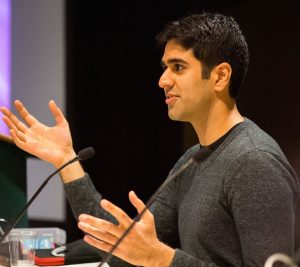How to develop successful tutorials, using marketing strategy from Motion and Brand Designer, Anthony Prats and advice from composer/sound designers, David Earl and Akash Thakkar.
Whether we’re aware of it or not, we are constantly being exposed to tutorials. Sometimes it’s because we’re actively searching for how to do something, but other times, we merely run across them while browsing through print media, blog posts, video channels, social media, etc. And yet, have you ever stopped to think about what makes some tutorials successful and others, well, a bit of a wash?
Measuring the accomplishments of one audio production or hardware focused tutorial over another can be tough, especially since there’s no real system defining tutorial “success.” However, what if we, as audio professionals, could define the success of our content based on a carefully crafted workflow created by an allied field? A field that derives meaning from it’s ability to design and produce content with a large degree of confidence? What if we looked to this field, to marketing, as an example of how we can create successful tutorials?
What do marketing professionals value when creating content?
A few weeks ago, the company I work for, Anki, released a video announcing their newest addition to the Overdrive product line: Supertrucks. Motion and Brand Designer Anthony was on the ground floor of creating the announcement video, responsible for concept, filming, and editing.[perfectpullquote align=”left” cite=”We wanted to focus on education of the content you get, but done in a tone that’s authentic to the experience we want you to feel.” link=”” color=”” class=”” size=”20″][/perfectpullquote] His content needed to teach audiences about Anki’s new robotics technology, while still cultivating the feeling of accessibility and excitement. “We wanted to focus on education of the content you get, but done in a tone that’s authentic to the experience we want you to feel,” says Anthony. “We want to make it so accessible that the viewer can easily see themselves controlling the truck in that bad ass way.” Okay, how did he make this happen?
“We started by asking ‘what are the key beats [of the video],’ and shot pretty uninstructed interviews. These [talking points] were things that came from them. It wasn’t something I wrote. After the conversations, we had a really good idea of the messaging, so it was clean and crisp in the editing phase.”
By breaking it down into four categories, we can use the phases of Anthony’s development as a rubric for how we create successful audio tutorials. Those categories are: 1.) define your audience, 2.) define the goal of your content, 3.) identify what your audience is looking for in your content, and 4.) organize your content in a way that is focused yet genuine.

- Define your audience.
As tutorial builders, knowing who our audience is sheds light on the kind of content we should be producing. “Your audience is really just an extension of yourself,” says San Francisco Bay Area composer and long time teacher, David Earl. “What kind of music do you like? What kind of stuff do you mix? What kind of world do you like to say you’re involved in?” Think of it as being surrounded by your friends, or close professional colleagues.
Seattle-based composer/sound designer Akash Thakkar, feels as though his audience is most commonly in the exact same position he is. “My general audience tends to be freelancers and composers/sound designers in the game industry. Some people work in studios, but the vast, vast majority are freelancers.”
Thinking about your audience in this way makes them more approachable and easier to talk to. It also helps you play to your strengths when thinking about what kind of tutorial you’re creating. Like Akash, as a freelance sound designer, chances are your audience is also freelance sound designers. This means that they’re probably more interested in topics surrounding sound design than music mixing, or some other off-shoot topic.

- Define the goal of your content.
Once we’ve identified our audience, we need to determine what our goal is for the content we’re creating. For Anthony, it meant education about a product while keeping an aura of anticipation and excitement. For audio tutorials, it means bringing an idea or workflow to the spotlight that hasn’t gained much traction yet. Or maybe we’re trying to answer a specific question that was asked of us by a friend or colleague. Or finally, maybe we’re trying to gain exposure for ourselves and our own brand, as a way of self marketing.
When Akash was in school, he started teaching as a way to develop students’ excitement for audio music and elevate the community’s working knowledge of the industry. David, on the other hand, loved dissecting audio tools and figuring out the function of every working part. Creating tutorials was his way of saying, “I banged my head against this, so you don’t have to.” [perfectpullquote align=”right” cite=”I banged my head against this, so you don’t have to.” link=”” color=”” class=”” size=”20″][/perfectpullquote]
Within our overarching goal guiding the content development process – the reason why we’re developing this information and what keeps us generating more – is a more contextual goal that we need to define on an individual basis. We need to ask ourselves, in this tutorial, is my goal to create a demonstration or application?
Demonstration tutorials are a hallmark of David’s teaching style: “If you’re doing a tutorial on a plug-in, then you look at the plugin and you say, ‘Hey look at all the knobs on this plug-in. Here are what these knobs are called. Here are what they do.” But what about application focused tutorials?
“I do [application tutorials] because I have more fun with it,” says Akash. “I like saying, alright, here’s this thing (a workflow), you can do with anything. If you take a machine sound like a drill, boost 500Hz and pitch shift it down and time stretch it, it sounds like a monster growl. But you can do this with any machine sound. I’m hoping with that people are able to work with their own stuff and not worry too much about ‘oh I don’t have that sound.’”
Constructing a demonstration or application tutorial ties into the overarching goal of why we’re developing content in the first place. When we are able to determine latter, we are then able to ask ourselves which of the former makes the most sense. For example, when creating tutorials that teach about tools and how to use them, David most often utilizes a demonstration workflow. Because Akash utilizes tutorials as a way of showing how specific sounds can be made, he often applies an application workflow.

- Identify what your audience is looking for in your content.
Our tutorials fall short if they only take into account what we want to show. To truly create a successful tutorial, we also need to think about what our audience wants to see. “There’s a video series I created,” says Akash, “on the sound for Hyper Light Drifter. This is purely for the fans of the game, to say ‘okay, here’s how sound design works,’ and to demystify component of the game industry for them.”
“Let’s say they have me at Winter Music Conference,” says David. “Everybody’s there, they’re on drugs, they’re there to see the dance music and go to the pool party. I’m not going to go up there and start talking about thresholds on a compressor. I’m going to be like… WOW!… I just want them to be mostly inspired.”
David and Akash each think critically about what kind of space their audience is in when exposed to their tutorial and what their goals are when viewing the content. Sometimes the audience is watching or reading a tutorial because they want to learn something. Perhaps they’re watching David talk about second order modulation, or are watching Akash explain how to create a gunshot sound effect. Other times, as we have seen explained above, our audience just wants to be inspired.
- Organize your content in a way that is focused yet genuine.
As tutorial creators, once we’ve identified our audience, our goals, and our audience’s goals, we finally need to build the structure in which our content will live and determine our tone for delivering that material. For Anthony, that meant scheduling interviews to obtain a genuine understanding of the product, building a concise message, and delivering that message efficiently.
For David, this content structure means building a well-defined, focused hierarchy that organizes not only your thoughts, but also the information as you present it to the audience: “I think it’s really important when you’re teaching something to make things feel like they’re in a box. When I talk about synthesizers, I break it down into threes. You have three main components: oscillator, filter, and amplifier. You have three parameters on each thing. Oscillator has pitch, wave, type of phase. Your filter has type of filter, cutoff, resonance. Your amplifier has volume, panning, effects. And then you break it down from there, keeping each stage succinct.”
[perfectpullquote align=”left” cite=”As I get more comfy with it, I become more ‘ah whatever; if some people leave great, but it will probably attract the right people more. -Akash Thakkar” link=”” color=”” class=”” size=”20″][/perfectpullquote]
Like David, Anthony emphasized the importance of compact material: “The content needs to be engaging at all steps,” he said. “It’s about efficiency more than length. If you can get it said in 30 seconds, say it in 30 seconds. Don’t spend a minute.”
But it’s more than just being efficient. In fact, efficiency alone can become robotic. “When I first started on YouTube,” says Akash, “I was really stilted and [robotically] ‘it has to be professional.’ But as I get more comfy with it, I become more ‘ah whatever; if some people leave great, but it will probably attract the right people more.’”
“I want to be very conversational,” says David. “I want you to feel like I’m talking to you and explaining how to do something. If you can present a complex idea in a style that’s relaxed, it’s really effective. Because then, people think that you know your shit. And a little bit of personal stuff in your channel is good to. It’s part of ‘being real.’”
Wrapping it all up.
The next time you watch or read a tutorial, I challenge you to think more critically about the four categories of success and how they apply to the content you’re enjoying. Because at the end of the day, some tutorial creators often tend to fly ‘by the seat of their pants.’ Having good mentors and a variety of learning experiences can help you build up to a level of expertise that allows you to produce good content. But beginning to think consciously about who we are creating tutorials for, and how we design and structure our material, is how elevate our work to something that is truly meaningful and successful.
A big thank you to David and Akash for their contributions to this article. You can follow them on Twitter @sflogicninja and @AkashThakkar.
